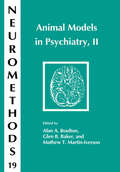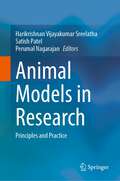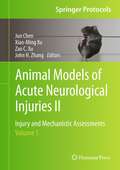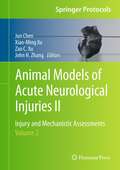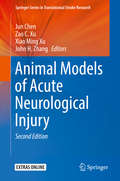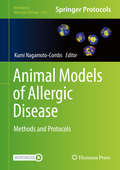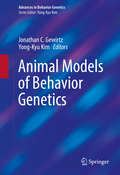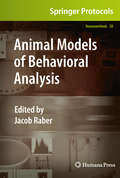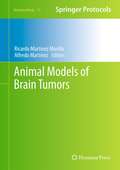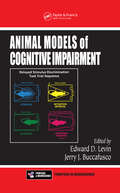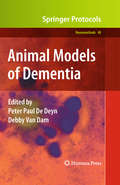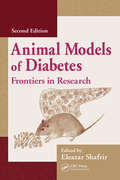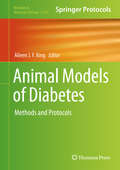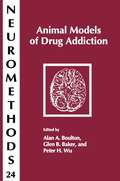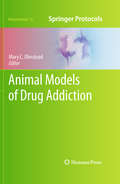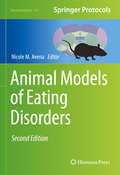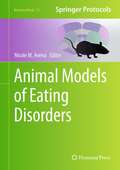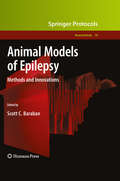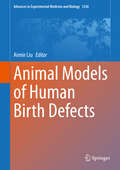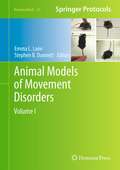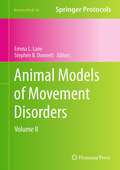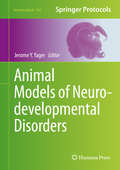- Table View
- List View
Animal Models in Psychiatry, II (Neuromethods #19)
by Alan A. Boulton Glen B. Baker Mathew T. Martin-IversonThe wealth of material presented in Animal Models in Psychiatry has necessitated its expansion into a comprehensive, two-volume work. <P><P> This initial volume opens with an introductory chapter on criteria for assessing the validity of animal models in psychiatry, providing a framework in which to evaluate subsequent chapters in both volumes. Chapters are devoted to specific psychiatric disorders, along with various procedures that have been proposed as potential animal models for understanding their etiology and management. <P> Contributors are renowned experts in their respective fields, and bring to light new insight into several animal models including: <P> * parallels to schizophrenia <P> * hippocampal lesions and schizophrenia <P> * stimulant psychoses <P> * hallucinations and continuous stimulants <P> * mania <P> * tardive dyskinesia <P> * activity anorexia <P> * attention deficit <P> * neuroleptic-induced oral dyskinesias.<P> Everyone involved in psychiatric research, general neuroscience, and a host of other disciplines will find Boulton, Baker, and Martin-Iverson's timely new volume an indispensable resource for both office and laboratory.
Animal Models in Research: Principles and Practice
by Harikrishnan Vijayakumar Sreelatha Satish Patel Perumal NagarajanThis book describes the development of animal models widely used in biomedical research using step-wise instructions and photographs. Showcasing a wide range of species from zebra fishes, birds, rodents, rabbits, dogs, and pigs, the book includes detailed methodology on how to work with these species and to develop various models. The animal models in neurology including stroke, Alzheimer’s disease, Parkinson’s disease, and Schizophrenia; Animal models in cancer research, sleep disorders, and cardiovascular diseases are described to meet the understanding of researchers who plan to replicate these models in their laboratories. In depth detailing on the development of targeted gene knockouts and transgenics, implantation models that are used in toxicology studies, and pharmacokinetic studies in pigs and dogs are a highlight. Further, the book describes pharmacologic, chemically induced, surgically induced, microbiologically induced, infectious models, models for neurobehavioral studies, oncology research, and pain research. The book has dedicated sections on anesthesia and analgesia and teaches procedures like venous cut-downs and cannulations in pigs and dogs, and endotracheal intubation, mechanical ventilation and thoracotomy in rodents and will serve as a self-training tool. Concepts in the field of animal model development are explained using examples. Sample size selection, study design, and statistical evaluation of experiments involving laboratory animals are explained to enable young researchers to practically understand the nuances. This book will be a valuable tool for academicians, students, scientists, and veterinarians and will benefit equally who are new to the field and who are already working with laboratory animals.
Animal Models in Toxicology
by Shayne Cox GadAnimal Models in Toxicology is a single-source reference for the use of animal models in toxicology. Chapters cover nine species used in toxicology and experimental biology. With contributions from experts in toxicology, toxicological pathology, and species-specific metabolism, each of these chapters provides an excellent introductory "course" alon
Animal Models of Acute Neurological Injuries II: Injury and Mechanistic Assessments, Volume 1 (Springer Protocols Handbooks)
by John H. Zhang Zao C. Xu Jun Chen Xiao-Ming XuThe successful previous volume on this topic provided a detailed benchwork manual for the most commonly used animal models of acute neurological injuries including cerebral ischemia, hemorrhage, vasospasm, and traumatic brain and spinal cord injuries. <P><P> Animal Models of Acute Neurological Injuries II: Injury and Mechanistic Assessments aims to collect chapters on assessing these disorders from cells and molecules to behavior and imaging. These comprehensive assessments are the key for understanding disease mechanisms as well as developing novel therapeutic strategies to ameliorate or even prevent damages to the nervous system. <P><P> Volume 1 examines general assessments in morphology, physiology, biochemistry and molecular biology, neurobehavior, and neuroimaging, as well as extensive sections on subarachnoid hemorrhage, cerebral vasospasm, and intracerebral hemorrhage. Designed to provide both expert guidance and step-by-step procedures, chapters serve to increase understanding in what, why, when, where, and how a particular assessment is used.<P><P> Accessible and essential, Animal Models of Acute Neurological Injuries II: Injury and Mechanistic Assessments will be useful for trainees or beginners in their assessments of acute neurological injuries, for experienced scientists from other research fields who are interested in either switching fields or exploring new opportunities, and for established scientists within the field who wish to employ new assessments.
Animal Models of Acute Neurological Injuries II: Injury and Mechanistic Assessments, Volume 2 (Springer Protocols Handbooks)
by John H. Zhang Zao C. Xu Jun Chen Xiao-Ming XuThe successful previous volume on this topic provided a detailed benchwork manual for the most commonly used animal models of acute neurological injuries including cerebral ischemia, hemorrhage, vasospasm, and traumatic brain and spinal cord injuries. Animal Models of Acute Neurological Injuries II: Injury and Mechanistic Assessments aims to collect chapters on assessing these disorders from cells and molecules to behavior and imaging. These comprehensive assessments are the key for understanding disease mechanisms as well as developing novel therapeutic strategies to ameliorate or even prevent damages to the nervous system. Volume 2 examines global cerebral ischemia, focal cerebral ischemia, and neonatal hypoxia-ischemia, as well as intensive sections covering traumatic brain injury and spinal cord injury. Designed to provide both expert guidance and step-by-step procedures, chapters serve to increase understanding in what, why, when, where, and how a particular assessment is used. Accessible and essential, Animal Models of Acute Neurological Injuries II: Injury and Mechanistic Assessments will be useful for trainees or beginners in their assessments of acute neurological injuries, for experienced scientists from other research fields who are interested in either switching fields or exploring new opportunities, and for established scientists within the field who wish to employ new assessments.
Animal Models of Acute Neurological Injury: Injury And Mechanistic Assessments, Volume 1 (Springer Series in Translational Stroke Research)
by John H. Zhang Zao C. Xu Jun Chen Xiao Ming XuDespite numerous recent studies and exciting discoveries in the field, only limited treatments are available today for the victims of acute brain and spinal cord injuries. Animal Models of Acute Neurological Injuries, Second Edition, provides a standardized methodology manual designed to eliminate the inconsistent preparations and variability that often inhibit advances in this specialized research field. In the 10 years since publication of the first edition of this book, some animal models have become obsolete, some have stood the test of time, and newer models have emerged to enhance our knowledge of acute neurological injuries. The second edition continues to offer the research community tested approaches for this area of investigation.As with the first edition, top experts have developed and contributed these animal models. The book’s focus remains hands-on, practical applications of the models, rather than a theoretical approach. Each chapter contains a proven procedure enhanced by clear figures, illustrations, or videos. This new edition presents its readily reproducible protocols with clarity and consistency to best aid neuroscientists and neurobiologists. As with the first edition, the second edition is comprehensive and cutting-edge. Animal Models of Acute Neurological Injuries, Second Edition, is an ideal guide for research professionals, at all stages of their careers, who wish to pursue this vital course of study with the proficiency and precision required by the field.
Animal Models of Allergic Disease: Methods and Protocols (Methods in Molecular Biology #2223)
by Kumi Nagamoto-CombsThis volume provides protocols for mouse models of allergic diseases and guidelines for choosing a particular strains, allergen, adjuvant, and route of sensitization. Chapters detail types of allergic disease, methods that are frequently employed to analyze pathophysiology of allergic diseases, manipulation of intestinal microbiota, and desensitization of immure responses in animal models. Written in the highly successful Methods in Molecular Biology series format, chapters include introductions to their respective topics, lists of the necessary materials and reagents, step-by-step, readily reproducible laboratory protocols, and tips on troubleshooting and avoiding known pitfalls. Authoritative and cutting-edge, Animal Models of Allergic Disease: Methods and Protocols aims to offer a comprehensive collection of protocols and experience-derived instructions to further allergic disease research.
Animal Models of Behavior Genetics (Advances in Behavior Genetics)
by Jonathan C. Gewirtz Yong-Kyu KimThis stimulating analysis reviews the broad potential of animal models to foster a deeper understanding of human pathology, strengthen connections between genetic and behavioral studies, and develop more effective treatments for mental disorders. Widely-studied and lesser-used species are examined in models that capture features along the continuum of normative and pathological behavior. The models highlight genetic causes of core features, or endophenotypes, of developmental, internalizing, and externalizing disorders, as well as dementia. Expert contributors address questions ranging from how suitable species are chosen for study to the costs and benefits of using inbred versus outbred strains, and the effects of housing environment on subject animals. Larger issues addressed include how to evaluate the applicability of animal behavioral models to the human condition and how these models can harness emerging molecular technologies to further our understanding of the genetic basis of mental illness. Included in the coverage: Mating and fighting in Drosophila. Attachment and social bonding. Impulsivity in rodents and humans. Animal models of cognitive decline. Animal models of social cognition. Future directions for animal models in behavioral genetics. A detailed map of where this evolving field is headed, Animal Models of Behavior Genetics shows geneticists, molecular biologists, and cognitive neuroscientists paths beyond established concepts toward a more knowledgeable and collaborative future.
Animal Models of Behavioral Analysis (Neuromethods #50)
by Jacob RaberDespite the difficulty in comparing clinic-based human tests with animal model testing, there is still great value in pursuing translational approaches, as tests and treatment strategies might be developed to improve brain function in humans suffering from neurological conditions and knowledge obtained from human behavioral studies can be used to further improve the animal models of behavioral analysis. In Animal Models of Behavioral Analysis, expert neuroscientists focus on approaches to translate and compare behavioral tests used in animals with those used in humans not only to increase our understanding of brain function across species but also to provide objective performance measures and bridge the gap between behavioral alterations in humans with cognitive disorders and the correlating animal models of these conditions. Written in the Neuromethods series format, the chapters provide authoritative reviews of many commonly used approaches in the field today. Provocative and cutting-edge, Animal Models of Behavioral Analysis seeks to aid researchers in further developing these vital techniques in an effort to advance studies in both the clinic and the laboratory.
Animal Models of Brain Tumors (Neuromethods #77)
by Alfredo Martínez Ricardo Martínez MurilloAlthough the available models, whether at the cellular, tissue, or animal level, do not exactly represent the biology of human brain tumors, animal models can offer significant insights into these tumors, providing a better understanding of biological mechanisms underlying tumor generation, growth, angiogenesis, invasion, and metastasis. Animal Models of Brain Tumors brings together developments and discoveries in "in vivo" experimental tumor research that have provided advances in our understanding of the cellular and molecular mechanisms involved in the generation, progression, and clinical outcome of brain neoplasms. Broken into convenient sections, this thorough volume includes topics such as animal model insights into human brain neoplasms, the cellular, molecular, and genetic basis of brain tumors, therapies in the treatment of malignant glioma, as well as imaging technologies in animal tumor models, i.e. measuring brain tumor growth and metabolism. Written for the popular Neuromethods series, chapters include the kind of detailed description and implementation advice that is essential for achieving successful results. Authoritative and cutting-edge, Animal Models of Brain Tumors provides the key methods needed to validate, compare, and contrast the animal model with its proposed human counterpart and further the understanding of our own serious ailments.
Animal Models of Cognitive Impairment
by Edward D. Levin Jerry J. BuccafuscoThe costs associated with a drug's clinical trials are so significant that it has become necessary to validate both its safety and efficacy in animal models prior to the continued study of the drug in humans.Featuring contributions from distinguished researchers in the field of cognitive therapy research, Animal Models of Cognitive Impairmen
Animal Models of Dementia (Neuromethods #48)
by Peter Paul De Deyn Debby Van DamWith an ever-increasing elderly population and the resultant rising levels of dementia-related disorders, preclinical research based on animal models is pivotal to our knowledge of underlying molecular mechanisms and drug discovery aiming at the development of therapeutic strategies alleviating or preventing the neurological devastation. In Animal Models of Dementia, expert researchers provide contributions that stress the importance of extensively validated animal models in drug discovery and development in order to predict clinical activity. Beginning with general aspects of animal modeling, related ethical issues, and essential methodological considerations, the highly detailed volume then continues with various levels of model validation, including pathological, behavioral, neurochemical, pharmacological, and imaging aspects, followed by sections focused on specific disorders, such as Alzheimer's disease, Parkinson's disease, metachromatic leukodystrophy and adrenoleukodystrophy, amyotrophic lateral sclerosis, frontotemporal dementia as well as vascular dementia and more. As a volume in the renowned Neuromethods series, this book offers a detailed, yet accessible, overview of currently available animal models in the field of dementia research, and touches, as well, upon more general areas linked to the development and use of animal models. Comprehensive and efficient, Animal Models of Dementia will significantly aid both experienced animal researchers as well as investigators on the verge of beginning animal model-based dementia research.
Animal Models of Diabetes: Frontiers in Research
by Eleazar ShafrirAs the incidence of diabetes increases worldwide, the need for recommendations on how to prevent and treat the condition grows exponentially, and so does the need for an authoritative source for information on the appropriate models to study the condition. The new edition of Animal Models of Diabetes is that source. The book presents updated
Animal Models of Diabetes: Methods and Protocols (Methods in Molecular Biology #2128)
by Aileen J. F. KingThis volume discusses a variety of animal models of diabetes, as well as describes techniques used to study end-points when using these models. The chapters in this book cover topics such as important considerations when working with mouse models of diabetes, highlighting factors that new investigators may not be aware of and some potential pitfalls in experimental outcomes; main characteristics of some commonly used animal models of diabetes research, ranging from mice to primates; animal models used to study specific aspects of beta-cell biology; and a focus on techniques used to assess blood glucose homeostasis, insulin action, and islet function in vivo and ex vivo. Written in the highly successful Methods in Molecular Biology series format, chapters include introductions to their respective topics, lists of the necessary materials and reagents, step-by-step, readily reproducible laboratory protocols, and tips on troubleshooting and avoiding known pitfalls.Cutting-edge and comprehensive, Animal Models of Diabetes: Methods and Protocols is a valuable resource that will help diabetes researchers design and carry out in vivo studies that will best suit their experimental questions and needs.
Animal Models of Drug Addiction (Neuromethods #24)
by Alan A. Boulton Glen B. Baker Peter H. WuA comprehensive guide to the use of animal models for understanding the many facets of drug and alcohol abuse-problems that are now worldwide health concerns. Expert investigators have contributed state-of-the-art chapters on the use of animal models for research on substance abuse.
Animal Models of Drug Addiction (Neuromethods #53)
by Mary C. OlmsteadOur understanding of addiction and how it is treated has advanced remarkably over the past decades, and much of the progress is related directly to animal research. This is true for both the behavioural aspects of drug use as well as the biological underpinnings of the disorder. In Animal Models of Drug Addiction, experts in the field provide an up-to-date review of complex behavioural paradigms that model different stages of this disorder and explain how each test is used to effectively replicate the progression of drug addiction. This detailed and practical book begins with the most common laboratory measures of addiction in animals, including intracranial self-stimulation (ICSS), drug self-administration, place conditioning, and sensitization. Later chapters describe how these paradigms are used to model the progression of drug addiction, providing insight into the clinical symptomatology of addiction from acquisition of drug use through compulsive drug taking to withdrawal and relapse. Written for the popular Neuromethods series, the contributions offer both methodological detail and a theoretical perspective, appealing to readers familiar with preclinical research on drug addiction as well as those who are newcomers to the field. Cutting-edge and authoritative, Animal Models of Drug Addiction will serve as a basis for future vital research that links the bench to the bedside in the crucial treatment of drug addiction.
Animal Models of Eating Disorders (Neuromethods #161)
by Nicole M. AvenaThis second edition volume expands on the previous edition with discussions on the latest techniques and animal models used to study eating disorders, and the characterizations of behaviors and neurochemical alterations associated with them. Chapters in this book cover different contributing factors of eating disorders and explore topics such as highlight processed food and binge eating; predicting and classifying rates prone to overeating fat; artificial sweeteners in animal models of binge eating; clinical and preclinical bariatric surgery approaches to studying obesity; anorexia and undereating; and food-anticipatory activity in rat models and its underlying mechanisms. In the Neuromethods series style, chapters include the kind of detail and key advice from the specialists needed to get successful results in your laboratory. Cutting-edge and practical, Animal Models of Eating Disorders, Second Edition is a valuable resource for any researchers interested in learning more about this important and developing field.
Animal Models of Eating Disorders (Neuromethods #74)
by Nicole M. AvenaThe growth of the field of eating disorder research has led to a vast array of empirical articles, and the development of new animal models that can be used to study these disorders continues to stimulate new research. Animal Models of Eating Disorders serves as a collection of detailed techniques contributed by experts in the field who are well-versed in the development and implementation of these models. Since eating disorders are complex and likely due to a combination of environmental, genetic, and social causes, the detailed chapters of this volume have been designed to highlight different contributing factors. Collectively, these chapters give a comprehensive and representative overview of both recently developed and classic methodologies used in the study of eating disorders. Written for the popular Neuromethods series, this work contains the kind of thorough description and implementation advice that promises successful results. Authoritative and practical, Animal Models of Eating Disorders aims to aid researchers in the use of animal models to assist in their investigation and characterization of the behaviors and neurochemical alterations associated with these devastating disorders.
Animal Models of Epilepsy: Methods and Innovations (Neuromethods #40)
by Scott C. BarabanWith its complex anatomical, molecular, electrophysiological and behavioral components, epilepsy provides the neuroscientist with nearly boundless opportunities to examine basic neurobiological mechanisms. In Animal Models of Epilepsy: Methods and Innovations, prominent investigators in the field examine several novel models of epilepsy in mice as well as in genetically tractable "simple" species such as Drosophila melanogaster (fruit flies), Caenorhabditis elegans (worms), Xenopus laevis (tadpoles) and Danio rerio (zebrafish). While covering some traditional models, the volume also explores the newest innovations like modeling seizure activity in silica and advanced strategies for seizure detection and gene therapy. As a volume in the successful NeuromethodsTM series, the chapters provide clear, step-by-step protocols and thought-provoking reviews of the most recent advancements in the field. Comprehensive and cutting-edge, Animal Models of Epilepsy: Methods and Innovations is an ideal guide for scientists who wish to expand our understanding of the pathogenesis of this neurological disorder.
Animal Models of Human Birth Defects (Advances In Experimental Medicine And Biology Series #1236)
by Aimin LiuThis book focuses on the use of animal models to study various human defects. It summarizes our current understanding of a variety of common human birth defects and the essential role of animal models in shedding light on the underlying mechanisms of these disorders. Birth defects are the leading cause of infant deaths, and cost billions of dollars in care for those affected. Unfortunately, the lack of a clear understanding of the mechanisms leading to many of these developmental disorders has hindered effective prevention and early intervention strategies. Studies using animal models have provided essential insights into several human birth defects. This book serves as a valuable reference resource for researchers and graduate students who are interested in learning the basic principles as well as the latest advances in the study of the mechanisms of human birth defects.
Animal Models of Human Birth Defects (Advances in Experimental Medicine and Biology #1236)
by Aimin LiuThis book focuses on the use of animal models to study various human defects. It summarizes our current understanding of a variety of common human birth defects and the essential role of animal models in shedding light on the underlying mechanisms of these disorders. Birth defects are the leading cause of infant deaths, and cost billions of dollars in care for those affected. Unfortunately, the lack of a clear understanding of the mechanisms leading to many of these developmental disorders has hindered effective prevention and early intervention strategies. Studies using animal models have provided essential insights into several human birth defects. This book serves as a valuable reference resource for researchers and graduate students who are interested in learning the basic principles as well as the latest advances in the study of the mechanisms of human birth defects.
Animal Models of Human Disease (Elements in the Philosophy of Biology)
by Sara GreenThe crucial role of animal models in biomedical research calls for philosophical investigation of how and whether knowledge about human diseases can be gained by studying other species. This Element delves into the selection and construction of animal models to serve as preclinical substitutes for human patients. It explores the multifaceted roles animal models fulfil in translational research and how the boundaries between humans and animals are negotiated in this process. The book also covers persistent translational challenges that have sparked debates across scientific, philosophical, and public arenas regarding the limitations and future of animal models. Among the are persistent tensions between standardization and variation in medicine, as well as between strategies aiming to reduce and recapitulate biological complexity. Finally, the book examines the prospects of replacing animal models with animal-free methods. The Element demonstrates why animal modeling should be of interest to philosophers, social scientists, and scientists alike.
Animal Models of Movement Disorders, Volume I: Volume I (Neuromethods #61)
by Stephen B. Dunnett Emma L. LaneMovement is the way that animals interact with their environment and is under the organization and complex control of the brain and spinal cord. Multiple central nervous systems, including cortex, basal ganglia, cerebellum, and brainstem, interact to provide precise motor control and integration. Damage or disease within these systems cause profound motor disturbances in man, which can be effectively modeled in animals to develop a better understanding and treatment of the human condition. Animal Models of Movement Disorders introduces a variety of methods and techniques used to model and assess motor function in experimental animals from lower orders, such as drosophila and c. elegans, through vertebrate species including fish, to mammals, such as rodents and non-human primates. The most advanced contemporary models in each system are presented at multiple levels of analysis from molecular and genetic modeling, lesions, anatomy, neurochemistry, to imaging and behavior. Volume I contains general methods of movement disorder assessment as well as an extensive section on dopamine systems. <P><P> Comprehensive and meticulous, Animal Models of Movement Disorders serves as a valuable reference for those studying motor disorders by covering methodologies in detail and providing the information necessary to consider both the appropriate models and assessment tools that can most informatively answer the key experimental issues in the field.
Animal Models of Movement Disorders, Volume II: Volume II (Neuromethods #62)
by Stephen B. Dunnett Emma L. LaneMovement is the way that animals interact with their environment and is under the organization and complex control of the brain and spinal cord. Multiple central nervous systems, including cortex, basal ganglia, cerebellum, and brainstem, interact to provide precise motor control and integration. Damage or disease within these systems cause profound motor disturbances in man, which can be effectively modeled in animals to develop a better understanding and treatment of the human condition. Animal Models of Movement Disorders introduces a variety of methods and techniques used to model and assess motor function in experimental animals from lower orders, such as drosophila and c. elegans, through vertebrate species including fish, to mammals, such as rodents and non-human primates. The most advanced contemporary models in each system are presented at multiple levels of analysis from molecular and genetic modeling, lesions, anatomy, neurochemistry, to imaging and behavior. Volume II of this detailed collection contains sections on the basal ganglia, neo- and allo-cortical systems, cerebellar and brain stem systems, as well as spinal cord systems.<P><P> Comprehensive and meticulous, Animal Models of Movement Disorders serves as a valuable reference for those studying motor disorders by covering methodologies in detail and providing the information necessary to consider both the appropriate models and assessment tools that can most informatively answer the key experimental issues in the field.
Animal Models of Neurodevelopmental Disorders (Neuromethods #104)
by Jerome Y. YagerProviding a spectrum of models that is reflective of the various species that can be utilized in experimentation on disorders across a broad range of developmental disabilities, this volume collects expert contributions involved in investigation of the causes, outcomes, treatment, and prevention. Animal Models of Neurodevelopmental Disorders explores models of perinatal hypoxia-ischemia/cerebral palsy and stroke, autism spectrum disorder, fetal alcohol syndrome, as well as mental retardation. Written in the popular Neuromethods series style, chapters include the kind of detail and key advice from the specialists needed to get successful results in your own laboratory. Practical and authoritative, Animal Models of Neurodevelopmental Disorders serves to introduce and entice those interested in better understanding and treating these disorders to the vital animal model world of investigation.
